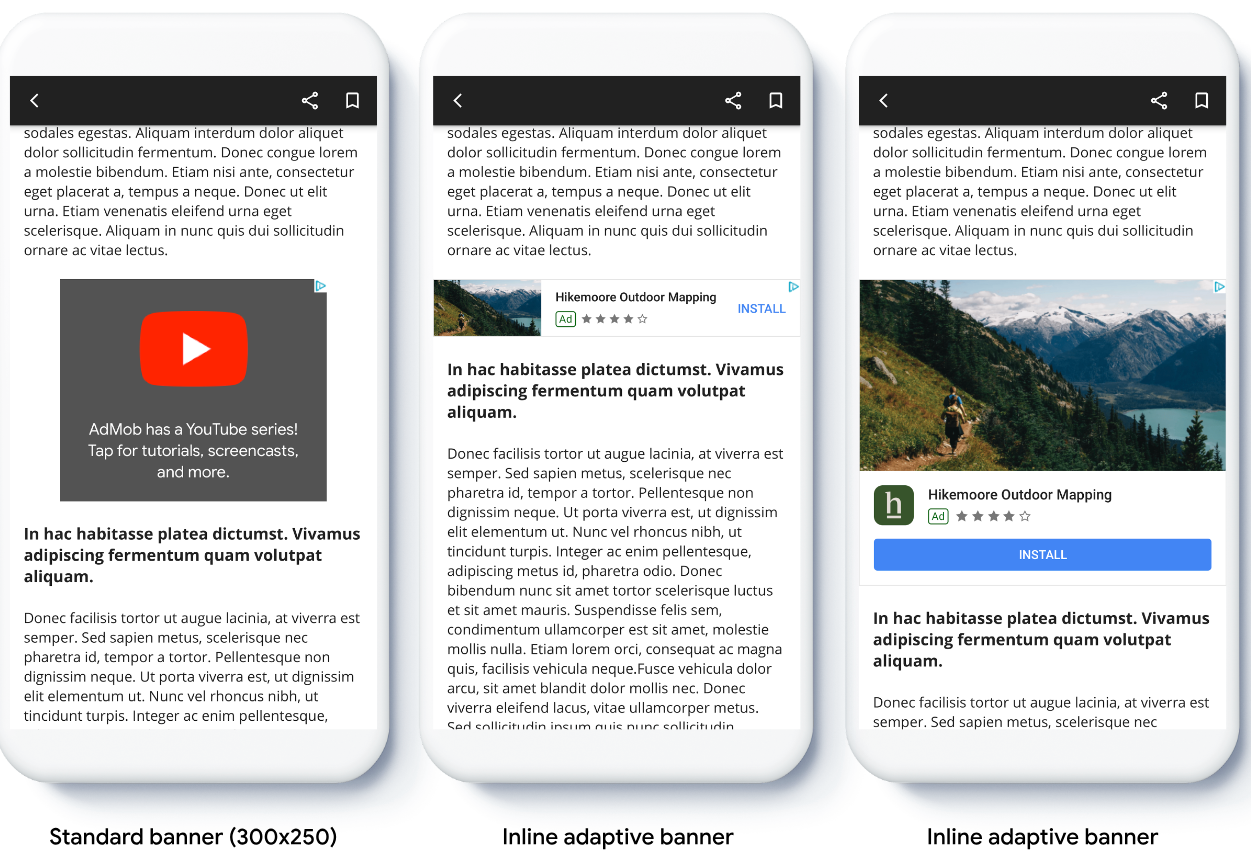采用自适应横幅广告时,您可以指定广告宽度,以确定最优的广告尺寸。自适应横幅广告还可针对每种设备优化广告尺寸,从而最大限度地提升广告效果。此方法有助于提升广告效果。
与锚定自适应横幅广告相比,内嵌自适应横幅广告更大、更高,并且使用的是可变高度而非固定高度。内嵌自适应横幅广告的高度可变,可能占据整个屏幕,也可能只达到您指定的高度上限。
您可以将内嵌自适应横幅广告放置在滚动显示的内容中,示例如下:

准备工作
在继续操作之前,请确保您已通读横幅广告入门指南。
植入自适应横幅广告
与锚定自适应横幅广告不同,内嵌自适应横幅广告使用内嵌自适应横幅广告尺寸进行加载。若要创建内嵌自适应广告尺寸,请完成以下操作:
获取所用设备的宽度,或者自行设置宽度(如果您不想使用屏幕的全宽)。
Kotlin
private val adWidth: Int get() { val displayMetrics = resources.displayMetrics val adWidthPixels = if (Build.VERSION.SDK_INT >= Build.VERSION_CODES.R) { val windowMetrics: WindowMetrics = this.windowManager.currentWindowMetrics windowMetrics.bounds.width() } else { displayMetrics.widthPixels } val density = displayMetrics.density return (adWidthPixels / density).toInt() }Java
public int getAdWidth() { DisplayMetrics displayMetrics = getResources().getDisplayMetrics(); int adWidthPixels = displayMetrics.widthPixels; if (VERSION.SDK_INT >= VERSION_CODES.R) { WindowMetrics windowMetrics = this.getWindowManager().getCurrentWindowMetrics(); adWidthPixels = windowMetrics.getBounds().width(); } float density = displayMetrics.density; return (int) (adWidthPixels / density); }如需获取适用于所选屏幕方向的内嵌自适应广告尺寸对象,请使用广告尺寸类中的静态方法:
Kotlin
val adView = AdView(this@MainActivity) adView.setAdSize(AdSize.getCurrentOrientationInlineAdaptiveBannerAdSize(this, adWidth))Java
final AdView adView = new AdView(MainActivity.this); adView.setAdSize(AdSize.getCurrentOrientationInlineAdaptiveBannerAdSize(this, getAdWidth()));在应用中植入自适应横幅广告时,请注意以下几点:
- 按照内嵌自适应横幅广告尺寸的设计,占满可用宽度时效果最佳。在大多数情况下,该尺寸指的是所用设备的屏幕全宽,或者横幅广告父级内容的全宽。您必须知道要放置广告的视图的宽度、设备宽度、父级内容宽度以及适用的安全区域。
根据屏幕方向调整内嵌自适应横幅广告尺寸
若要以特定屏幕方向预加载内嵌自适应横幅广告,请使用以下方法:
AdSize.getPortraitInlineAdaptiveBannerAdSize(Context context, int width)AdSize.getLandscapeInlineAdaptiveBannerAdSize(Context context, int width)
如果您的应用同时支持纵向视图和横向视图,并且您想以当前屏幕方向预加载自适应横幅广告,请使用
AdSize.getCurrentOrientationInlineAdaptiveBannerAdSize(Context context, int width)。此方法会以当前屏幕方向加载广告。限制内嵌自适应横幅广告的高度
默认情况下,如果内嵌自适应横幅广告在实例化时未指定
maxHeight,其maxHeight值会等于设备高度。若要限制内嵌自适应横幅广告的高度,请使用AdSize.getInlineAdaptiveBannerAdSize(int width, int maxHeight)方法。其他资源
GitHub 示例
下载示例应用,查看内嵌自适应横幅广告的实际效果。
